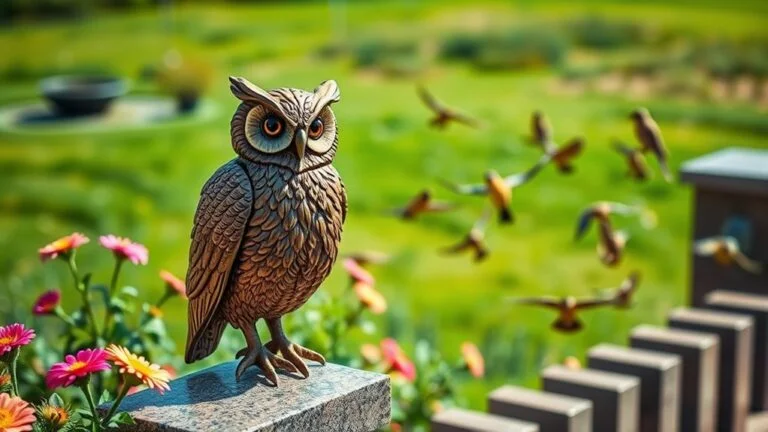How To Keep Birds Off Patio Furniture? – Maintain a Clean, Enjoyable Space
Outdoor furniture adds comfort and style to your patio, but unwanted feathered visitors can quickly turn your relaxing space into a messy problem.
Birds perching on your patio furniture can leave behind droppings, feathers, and even cause damage.
Fortunately, there are numerous effective methods to keep birds away from your outdoor furniture, allowing you to enjoy your patio in peace.

Key Takeaways:
- Visual deterrents: Use reflective objects like aluminum foil strips or reflective tape to create an uncomfortable environment for birds.
- Physical barriers: Install bird netting or spikes to prevent birds from landing on furniture.
- Decoys and predators: Place fake predators like owls or hawks to scare birds away.
- Sound deterrents: Utilize wind chimes or ultrasonic devices to create an unwelcoming atmosphere for birds.
- Repellent sprays: Apply bird-repellent sprays with citrus scents to make furniture less appealing.
- Alternative perching spots: Provide birdhouses or feeders away from your patio area to redirect birds.
- Regular cleaning: Maintain a clean patio free of food scraps to reduce bird attraction.
- Strategic furniture placement: Position furniture away from common bird perching areas.
- Sealants and covers: Apply protective sealants or use furniture covers when not in use.
- Natural deterrents: Plant bird-repelling herbs or use essential oils to create an unpleasant environment for birds.
- Motion-activated devices: Install motion-activated sprinklers or lights to startle birds.
- Consistent application: Combine multiple methods and apply them consistently for best results.
Harnessing the Power of Visual Deterrents to Keep Birds at Bay
Visual deterrents are an effective and non-harmful way to keep birds off your patio furniture. Birds are naturally wary of shiny, reflective objects that create unpredictable light patterns.
One simple yet effective method is to hang strips of aluminum foil or reflective tape around your patio area.
The constant movement and light reflection from these materials can disorient birds and make them uncomfortable, discouraging them from landing on your furniture.
Another visual deterrent option is to use scare-eye balloons or reflective pinwheels. These items mimic the appearance of predator eyes or create sudden movements that startle birds.
Placing these strategically around your patio can create an environment that birds find unsettling, prompting them to seek alternative resting spots.
It’s important to regularly move or change the position of these visual deterrents to prevent birds from becoming accustomed to them.
By maintaining an element of unpredictability, you can ensure the continued effectiveness of these simple yet powerful bird-repelling techniques.
Implementing Physical Barriers for Effective Bird Control

Physical barriers provide a tangible solution to keep birds off your patio furniture. Bird netting is a highly effective method that creates an impenetrable shield against avian intruders.
By carefully draping lightweight mesh netting over your furniture or entire patio area, you establish a physical boundary that prevents birds from landing or nesting.
Ensure the netting is properly secured to maintain its effectiveness and aesthetic appeal.
Another popular physical deterrent is the use of bird spikes. These can be installed on surfaces where birds commonly perch, such as the edges of furniture or nearby ledges.
The spikes make it uncomfortable for birds to land, encouraging them to find alternative resting spots. It’s crucial to choose bird spikes that are designed to deter without causing harm to the birds.
For a less visible option, consider using transparent fishing line or monofilament. Stringing these lines across your patio area creates an obstacle course that birds find challenging to navigate.
The nearly invisible nature of these lines maintains the aesthetic of your outdoor space while effectively deterring birds.
Employing Decoys and Predator Replicas to Scare Birds Away
Utilizing decoys and predator replicas is an ingenious way to tap into birds’ natural instincts and keep them away from your patio furniture.
Plastic owls, hawks, or even snake replicas can be strategically placed around your outdoor area to create the illusion of danger.
Birds are inherently wary of these predators and will typically avoid areas where they perceive a threat.
To maximize the effectiveness of decoy predators, it’s essential to periodically move them to different locations.
This movement prevents birds from becoming accustomed to the static presence of the decoy and maintains the illusion of a real threat.
Some decoy products even come with moving parts or reflective eyes to enhance their realism and effectiveness.
Consider combining different types of predator decoys for a more comprehensive approach. For instance, placing an owl decoy near ground level and a hawk replica at a higher vantage point can create a multi-layered deterrent system.
Remember that the key to success with this method is to maintain the element of surprise and keep birds guessing about the safety of your patio area.
Harnessing Sound Deterrents to Create an Unwelcoming Atmosphere

Sound deterrents can be highly effective in keeping birds away from your patio furniture by creating an uncomfortable auditory environment. Wind chimes are a popular and aesthetically pleasing option that serve a dual purpose.
Not only do they add a pleasant ambiance to your outdoor space, but the unpredictable sounds they produce can also startle and deter birds from settling in the area.
For a more targeted approach, consider using ultrasonic bird repellers. These devices emit high-frequency sounds that are inaudible to humans but irritating to birds.
They can be strategically placed around your patio to create an invisible barrier of sound that discourages birds from approaching your furniture.
Another option is to use predator bird calls or recordings of distress calls from the specific bird species you’re trying to deter. These sounds can trigger a flight response in birds, making them perceive your patio as an unsafe area.
It’s important to vary the sounds and timing of these deterrents to prevent birds from becoming accustomed to them.
Applying Bird Repellent Sprays and Gels for Added Protection
Bird repellent sprays and gels offer a direct and targeted approach to keeping birds off your patio furniture. These products typically contain ingredients that birds find unpleasant, such as grape seed extract or citrus oils.
When applied to surfaces where birds commonly perch, these repellents create an inhospitable environment that discourages birds from landing or nesting.
Many bird repellent sprays are designed to be non-toxic and environmentally friendly, ensuring they won’t harm birds or other wildlife. They work by making the treated surfaces sticky or uncomfortable for birds to land on.
Some repellents also emit odors that birds find offensive, further deterring them from the area.
When using repellent sprays or gels, it’s crucial to follow the manufacturer’s instructions carefully. Regular reapplication may be necessary, especially after rain or heavy dew.
For best results, combine the use of repellents with other deterrent methods to create a comprehensive bird control strategy for your patio furniture.
Providing Alternative Perching Spots to Redirect Bird Activity
One effective strategy to keep birds off your patio furniture is to offer them more attractive alternatives.
By strategically placing birdhouses, feeders, or birdbaths in areas away from your patio, you can redirect bird activity to these designated spots.
This approach not only protects your furniture but also allows you to enjoy the presence of birds in your yard from a comfortable distance.
When selecting alternative perching spots, consider the types of birds common in your area and their preferences.
Different bird species have varying needs for nesting and feeding, so offering a variety of options can increase the effectiveness of this method.
Place these alternatives in quiet, sheltered areas of your yard to make them more appealing to birds than your exposed patio furniture.
It’s important to maintain these alternative spots regularly by cleaning feeders, refreshing water in birdbaths, and ensuring birdhouses are in good condition.
This upkeep will encourage birds to consistently use these areas instead of your patio furniture, creating a win-win situation for both you and your feathered visitors.
Maintaining a Clean Patio to Reduce Bird Attraction
Keeping your patio area clean is a simple yet crucial step in deterring birds from your outdoor furniture.
Birds are often attracted to areas where they can find food scraps or crumbs, so regular cleaning can significantly reduce their interest in your patio.
After outdoor meals or gatherings, make it a habit to promptly clean up any food debris and wipe down surfaces.
Pay special attention to areas under and around your patio furniture, as these spots can accumulate fallen food particles that may attract birds.
Using a broom or leaf blower to regularly clear your patio of debris can help maintain a clean environment that’s less appealing to birds.
Additionally, if you have potted plants or gardens near your patio, ensure they are well-maintained. Overgrown plants or fallen fruits can attract insects, which in turn may draw birds to the area.
By keeping your entire outdoor space tidy, you create an environment that’s less inviting to birds and other pests.
Strategic Furniture Placement to Minimize Bird Interference
The strategic placement of your patio furniture can play a significant role in minimizing bird interference. Consider positioning your furniture away from overhanging branches, eaves, or other structures that birds commonly use as perches.
By creating distance between these natural roosting spots and your furniture, you make it less convenient for birds to access your patio area.
If possible, place your furniture closer to areas of human activity or near your home’s entrance. Birds are generally more cautious about approaching areas with frequent human presence.
Additionally, consider using umbrellas or patio covers to shield your furniture from above, making it more difficult for birds to land directly on your seating areas.
When arranging your patio layout, try to avoid creating isolated or quiet corners where birds might feel comfortable nesting.
Instead, opt for an open arrangement that allows for easy movement and visibility across the entire patio space.
This openness can make birds feel more exposed and less likely to settle on your furniture.
Applying Protective Sealants and Using Furniture Covers
Protecting your patio furniture with sealants and covers can be an effective way to deter birds and preserve your outdoor investments.
Furniture sealants designed to repel birds often contain ingredients that make surfaces slippery or uncomfortable for birds to perch on.
These products can be applied directly to your furniture, creating an invisible barrier that discourages birds from landing.
When selecting a sealant, opt for products that are weather-resistant and safe for use on outdoor materials.
Follow the manufacturer’s instructions carefully for application and reapplication schedules to ensure ongoing effectiveness.
Some sealants may need to be reapplied more frequently in areas with high rainfall or intense sun exposure.
In addition to sealants, using furniture covers when your patio is not in use can provide an extra layer of protection. Choose covers that are waterproof and securely fitted to prevent birds from nesting underneath them.
Some covers even come with built-in bird-repelling features, such as reflective surfaces or spikes, offering dual protection for your furniture.
Utilizing Natural Deterrents and Essential Oils
Harnessing the power of nature can be an effective and eco-friendly way to keep birds off your patio furniture. Many birds are naturally repelled by certain strong scents and plants.
Consider planting herbs like peppermint, rosemary, or lavender around your patio area. These aromatic plants not only add beauty to your outdoor space but also create an environment that birds find unappealing.
Essential oils can also be used as a natural bird deterrent. Oils such as peppermint, citronella, or eucalyptus are known to repel birds.
You can create a simple spray by mixing a few drops of these essential oils with water in a spray bottle.
Apply this mixture to your patio furniture or surrounding areas regularly, especially after rain.
Another natural approach is to use predator urine or similar scent-based products that mimic the presence of natural bird predators.
While this method may not be suitable for all settings, it can be highly effective in creating an environment that birds perceive as unsafe, encouraging them to seek alternative areas.
Implementing Motion-Activated Devices for Bird Control
Motion-activated devices offer a high-tech solution to keep birds away from your patio furniture. These systems use sensors to detect movement and trigger a response that startles birds, discouraging them from settling in the area.
Motion-activated sprinklers are particularly effective, as they not only startle birds with sudden movement but also spray water, creating an unpleasant experience for any feathered visitors.
Another option is motion-activated lights or sound devices. These can be set up to emit sudden flashes of light or predator sounds when birds approach, creating an environment that feels unsafe and unpredictable.
Some advanced systems even use a combination of light, sound, and water spray for maximum effectiveness.
When installing motion-activated devices, consider their placement carefully to ensure they cover the most crucial areas of your patio.
It’s also important to adjust the sensitivity of these devices to avoid false triggers from smaller animals or wind-blown objects.
Regularly check and maintain these devices to ensure they continue to function effectively as a bird deterrent.
Combining Methods for Maximum Effectiveness
To achieve the best results in keeping birds off your patio furniture, it’s often most effective to combine multiple deterrent methods.
By implementing a variety of strategies, you create a multi-layered defense that addresses different aspects of bird behavior and preferences.
This comprehensive approach makes your patio area consistently unappealing to birds, reducing the likelihood of them adapting to any single deterrent method.
For example, you might use reflective tape and wind chimes for visual and auditory deterrence, while also applying a bird repellent spray to your furniture.
Complement these with strategically placed predator decoys and ensure your patio is kept clean of food debris.
By utilizing a combination of physical, visual, auditory, and olfactory deterrents, you create an environment that birds find consistently unwelcoming from multiple sensory perspectives.
Remember to regularly rotate or change your deterrent methods to prevent birds from becoming accustomed to them.
What works well one season might become less effective over time, so be prepared to adapt your strategy as needed.
Consistency in application and maintenance of these combined methods is key to long-term success in keeping your patio furniture bird-free.
Frequently Asked Questions
How often should I reapply bird repellent sprays to my patio furniture?
The frequency of reapplication depends on the specific product and environmental conditions. Generally, it’s recommended to reapply every 2-4 weeks, or after heavy rain.
Always check the manufacturer’s instructions for the most accurate guidance.
Are ultrasonic bird repellers safe for pets?
Most ultrasonic bird repellers are designed to be safe for pets, as they operate at frequencies that primarily affect birds. However, some sensitive pets might be disturbed.
It’s best to observe your pets’ behavior after installation and adjust if necessary.
Can I make my own bird repellent spray at home?
Yes, you can create a homemade bird repellent spray using ingredients like peppermint oil, water, and a small amount of dish soap. Mix these in a spray bottle and apply to your furniture.
However, commercial products are often more long-lasting and effective.
Will bird spikes damage my patio furniture?
When properly installed, bird spikes should not damage your furniture. They are typically designed to be attached without causing harm to the underlying surface.
Always follow the manufacturer’s installation instructions carefully.
How can I deter birds without harming them?
Most methods mentioned in this guide, such as visual deterrents, sound devices, and repellent sprays, are designed to deter birds without causing harm.
Focus on making your patio area unappealing rather than using harmful tactics.
Is it legal to use bird deterrents on my property?
Generally, non-harmful bird deterrents are legal for use on private property. However, some areas may have restrictions on certain methods, especially regarding protected bird species.
It’s always best to check local regulations before implementing any bird control measures.

Hello, I’m Amelia White, the founder of birdsfanatic.com. As a lifelong bird enthusiast and spiritual seeker, I’ve always been fascinated by the mystical connections between birds and the human experience. On this site, I share my knowledge and insights into the symbolic meanings and spiritual significance of various bird species, exploring their roles in mythology, folklore, and cultural traditions. Join me on this journey into the world of birds, where we’ll discover the hidden wisdom and guidance that these magnificent creatures have to offer.







